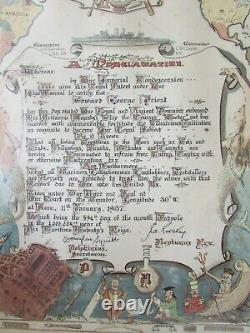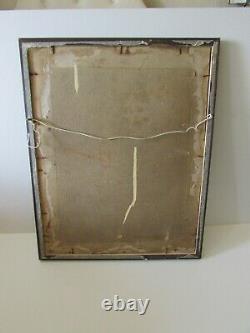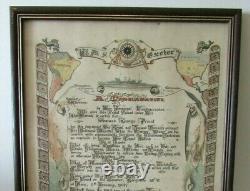
- Great Britain Rare
- Denomination
- Era
- 1700s (4)
- 1800s (14)
- 1816-1913 (22)
- 1900s (4)
- 1914-1945 (126)
- 1920s (6)
- 1945-present (73)
- 1970s (3)
- 2000s (7)
- Elizabeth Ii (3)
- George V (5)
- George V (1910-1936) (33)
- George Vi (2)
- Milled (1816-1837) (7)
- Pre - 1700s (4)
- Queen Victoria (4)
- Victoria (8)
- Victoria (1837-1901) (89)
- Victoria (1840-1901) (16)
- Wwii (2)
- ... (3721)
- Grade
- Place Of Origin
- Quality
- Year Of Issue
Rare HMS EXETER 1937 Crossing the Line (Equator) Initiation Document GRAF SPEE









Rare (personalised) HMS EXETER Document/Poster. A Proclamation Dated 1937, b. Eing a Royal Navy'Crossing the Line' (Equator) Initiation Ceremony Document. (relisted due to non payer). Document size: about 14 x 11 inches. Frame size: about 15 x 12 inches. Genuine Initiation Document - as issued to Naval Crew of HMS Exeter. A very interesting document relating to HMS EXETER, a WW2 warship involved in the British Naval assault on German battleship ADMIRAL GRAF SPEE, and Battle of the River Plate of 1939. Here we offer a fascinating and very unusual old CROSSING THE LINE document /poster, being "A Proclamation" printed in. And Olde English type language as befits such a maritime certificate, and employing a rather humorous tone. "Proclamation" was for Naval crew of HMS Exeter relating to a ritual or ceremony known as'Crossing the Line'. It signs off at the bottom referring to. "Dolphinius secretarius" and "Neptunus Rex", which is obviously a touch of Naval humour. A personalised document, as presented to Edward George Priest on this occasion.
The old English text refers to "Illustrious Initiation" and also mentions the Equator and Neptune, which suggests this document was awarded to those that passed the initiation known as "Crossing the Line" (an Equator Crossing Ritual). Apparently these rituals were often quite rough affairs! The language used in this document is very much. With the information on this topic - shown below.
The ceremony of Crossing the Line is an initiation rite in the British Merchant Navy, Dutch merchant navy, Royal Navy , and other navies that commemorates a sailor's first crossing of the Equator. The tradition may have originated with ceremonies when passing headlands, and become a "folly" sanctioned as a boost to morale. Sailors who have already crossed the Equator are nicknamed (Trusty/Honorable) Shellbacks , often referred to as Sons of Neptune those who have not are nicknamed (Slimy) Pollywogs in 1832 the nickname griffins was noted.
Equator-crossing ceremonies, typically featuring King Neptune, are also sometimes carried out for passengers' entertainment on civilian ocean liners and cruise ships. They are also performed in the merchant navy and aboard sail training ships.
As late as World War II, the line-crossing ceremony was still rather rough and involved activities such as the "Devil's Tongue", which was an electrified piece of metal poked into the sides of those deemed pollywogs. Beatings were often still common, usually with wet firehoses, and several World War II Navy deck logs speak of sailors visiting sick bay.
This document dates from just prior to WW2 and refers to these Naval officers. HMS Exeter was the second and last York-class heavy cruiser built for the Royal Navy during the late 1920s.
When World War II began in September 1939, the cruiser was assigned to patrol South American waters against German commerce raiders. Exeter was one of three British cruisers that fought the German pocket battleship the Admiral Graf Spee, later that year in the Battle of the River Plate. The Battle of the River Plate.
Was the first naval battle in the Second World War and the first one of the Battle of the Atlantic in South American waters. The German heavy cruiser Admiral Graf Spee had sailed into the South Atlantic two weeks before the war began, and had been commerce raiding after receiving appropriate authorisation on 26 September 1939. One of the hunting groups sent by the British Admiralty to search for Admiral Graf Spee, comprising three Royal Navy cruisers, HMS Exeter, Ajax and Achilles, found and engaged their quarry off the estuary of the River Plate close to the coast of Uruguay and Argentina in South America.
This fascinating document dates from just 2 years prior to the above action in WW2. This is an attractive old document festooned with mermaids and other maritime imagery including Neptune, along with a nice image of HMS Exeter and associated Naval motif, and also a list of foreign ports down both sides. A great talking point, and a.
Fascinating bit of Naval history! The item "Rare HMS EXETER 1937 Crossing the Line (Equator) Initiation Document GRAF SPEE" is in sale since Thursday, November 5, 2020. This item is in the category "Collectables\Militaria\Other Militaria\Navy".
The seller is "devonattic22" and is located in Paignton,. This item can be shipped worldwide.- Country/Region of Manufacture: United Kingdom
- Country/ Organization: Great Britain
- Issued/ Not-Issued: Issued
- Theme: Militaria
- Item type: Framed poster / document
- Ship: HMS Exeter
- Related to:: Admiral Graff Spee
- Type: Documents & Maps
- Conflict: World War II (1939-1945)
- Service: Navy
- Era: 1914-1945

